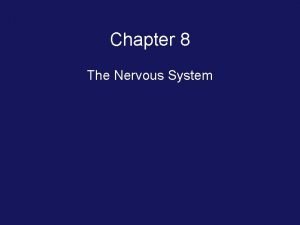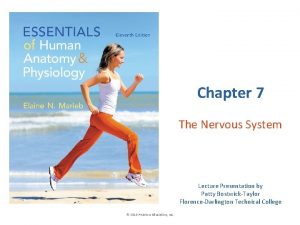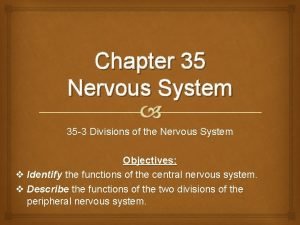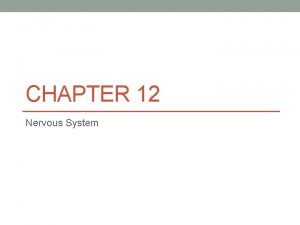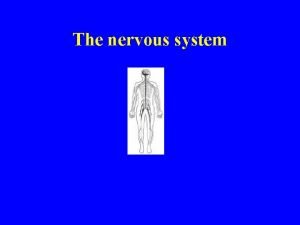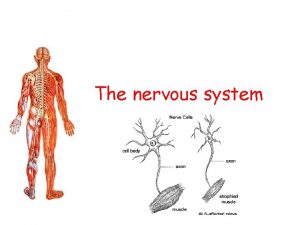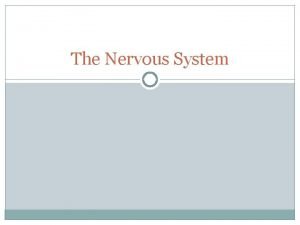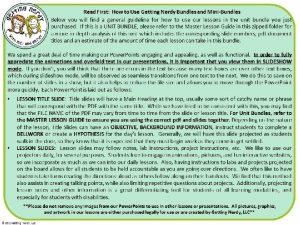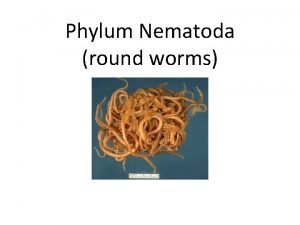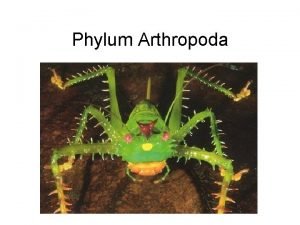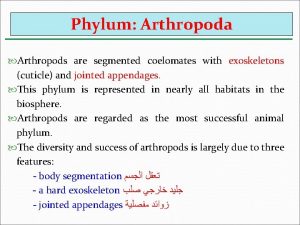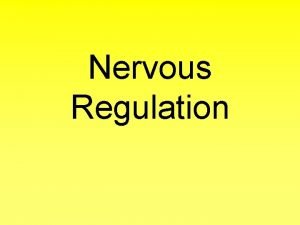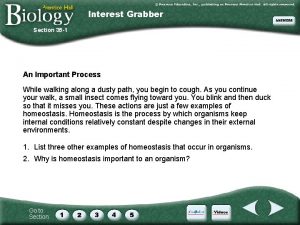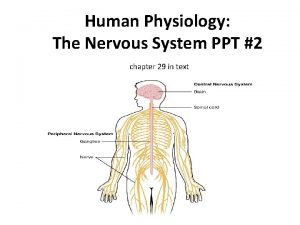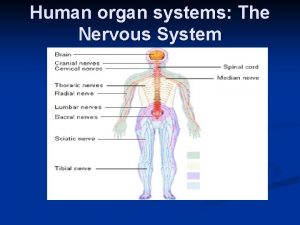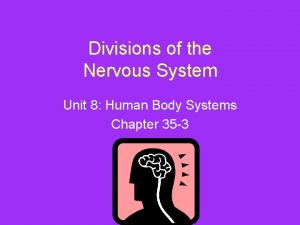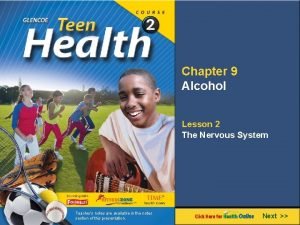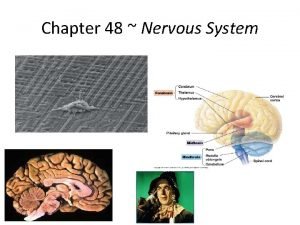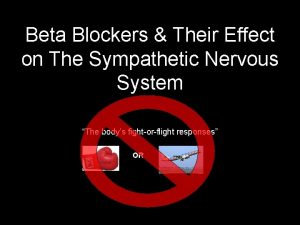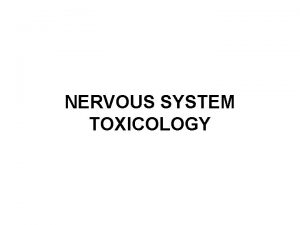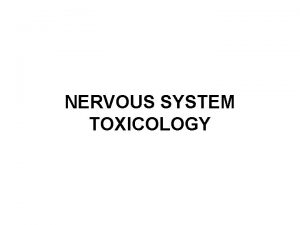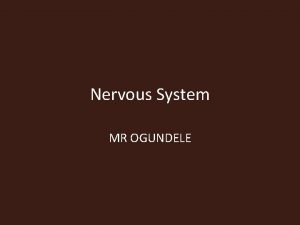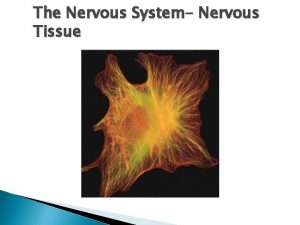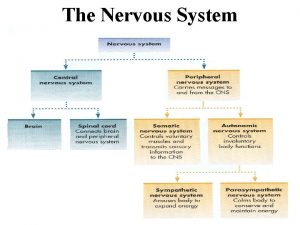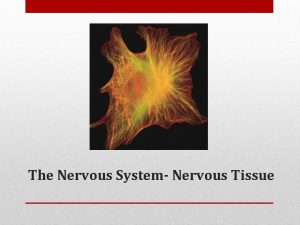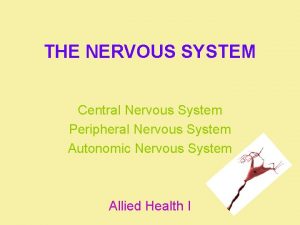Chapter 8 The Nervous System The Nervous System


















































- Slides: 50

Chapter 8 The Nervous System

The Nervous System Consists of the Central and Peripheral Nervous Systems


Principle Parts of Nervous System • Central Nervous System (CNS) – Components: brain and spinal cord • Peripheral Nervous System (PNS) – Components: nerves outside CNS – Sensory neurons: carry information toward the CNS – Motor neurons: carry information away from CNS

Central Nervous System • CNS protection and support – Bone: skull and vertebrae – Blood-brain barrier: regulates entry of molecules • Spinal cord: – Information highway for peripheral nerves to and from the brain • Relays information through nerve tracts in white matter – Grey matter: cell bodies of reflex center


Brain: Major Divisions

Functions of Various Areas of the Brain

Brain: Major Divisions • Brain stem (especially the medulla oblongata) – Evolutionarily primitive part of brain – Maintains vital life functions: • heartbeat, breathing rhythm, blood pressure, swallowing, coughing, sneezing, hiccupping

Brain: Major Divisions • Cerebellum: coordinates basic movements – Sensory-motor coordination (awareness of body parts in space) – Learned motor patterns 1. Throwing a ball 2. Gymnastics 3. Driving a manual transmission auto

The Brain: Hypothalamus • The hypothalamus coordinates the nervous and endocrine systems through its connection to the pituitary gland – It is a center for emotions and serves as the master biological clock

Brain: Major Divisions • Hypothalamus: Controls & integrates activities of: – – Autonomic NS: heart rate, body temp, emotions, etc. Pituitary gland hormones Hunger/satiety Puberty – Pleasure center in limbic system

Brain: Thalamus • Thalamus: receiving, processing, and transfer center – Sorts and integrates information – Sends threatening information to the amygdala

Brain: Cerebrum/cerebral cortex • Cerebrum/cerebral cortex – – – Most evolutionarily advanced part of the brain Cerebral cortex - gray matter is unmyelinated. Nerve cell bodies and glial cells. White matter - consists of myelinated axons that transmit impulses to other areas.


Which of the following most closely reflects the organization of the brain? A. Each brain area is a “jack of all trades and master of none” B. The left brain is dominant over the right C. New input first goes to all areas of the brain for evaluation D. Each area of the brain is specially adapted to perform one or a few specific tasks

Brain: Cerebrum/cerebral cortex (cont) • Cerebrum/cerebral cortex – Left hemisphere controls right hand, logic, scientific, analytical functions – Right hemisphere controls left hand, artistic awareness, imagination, integrates info to understand the whole picture


Differences between gray matter and white matter include: A. Gray matter does not contain synapses; white matter does. B. White matter is largely composed of myelinated axons; gray matter is not. C. White matter functions primarily to transmit impulses to other areas of the CNS.

The Brain: Corpus callosum • The corpus callosum connects the two cerebral hemispheres • Corpus callosum - communication between right and left hemisphere • The corpus callosum is sometimes severed in patients with severe epileptic seizures. The results illustrate how the right and left halves of the cerebrum have different functions.


• Cerebrum/cerebral cortex – Primary motor area and primary sensory area (cortex)


The horseshoe-shaped part of the cerebral cortex that receives information from receptors in the skin regarding touch, pain and temperature is called the: A. B. C. D. E. Diencephalon limbic region primary motor cortex (area) primary somatosensory cortex (area) hypothalamus

The horseshoe-shaped part of the cerebral cortex that sends messages that cause movement of muscles in all parts of the body (e. g. , arms, legs, etc. ) is called the: A. B. C. D. E. Diencephalon limbic region primary motor cortex (area) primary somatosensory cortex (area) hypothalamus

Suppose you wanted to invent an implantable device (e. g. , a computer chip) that would restore movement to a limb that was paralyzed due to a brain injury. The device would work by stimulating existing nerves to send messages to cause contraction of the non-functioning limb muscles. Which part of the brain would be the best place to implant this device? A. B. C. D. Corpus callosum limbic region primary motor cortex (area) primary somatosensory cortex (area)

Association Areas • Prefrontal cortex – Most highly advanced association area – Makes judgments about appropriate responses – Predicts consequences and judges which is the best response – Important in long-term planning, abstract ideas, complex learning, intellect, and personality


The Cerebellum • The cerebellum integrates information from the motor cortex and sensory pathways to produce movements • It also stores memories of learned motor skills.

The Medulla Oblongata • The medulla oblongata contains reflex centers to regulate the rhythm of breathing, force and rate of the heartbeat, and blood pressure – It serves as the pathway for all sensory messages to the higher brain centers and motor messages leaving the brain


The Limbic System • The limbic system, which includes several brain structures, is largely responsible for emotions

Limbic System

Limbic system: The “Emotional Brain” • Several neuronal pathways involved in (linking) emotions and memory • Includes thalamus, hypothalamus, hippocampus, amygdala, olfactory bulb • Allows us to experience emotions such as anger, fear, joy, sorrow, and sexual pleasure

The Spinal Cord Transmits Messages to and from the Brain and Is a Reflex Center







A knee-jerk reflex involves which of the following element(s) of the nervous system? (Choose the single best answer) A. B. C. D. E. Sensory neuron Motor neuron Interneuron Spinal cord All of the above

The Peripheral Nervous System Consists of the Somatic and Autonomic Nervous Systems • The somatic nervous system controls conscious functions • The autonomic nervous system controls internal organs (unconscious)

Quick Review: Peripheral Nervous System • Peripheral Nervous System (PNS) – Components: nerves outside CNS – Sensory neurons: carry information toward the CNS – Motor neurons: carry information away from CNS

Motor Neuron Divisions of PNS • Sympathetic (sub)division – Call to action: Readies body for "fight or flight", increased energy expenditure, stress or fear –Widespread effects on body – Opposes parasympathetic division

Motor Neuron Divisions of PNS • Parasympathetic (sub)division – Conserves and restores body energy (rest and relaxation) – More localized effect than Sympathetic NS –Opposes sympathetic division



Which of the following is an action of the sympathetic nervous system? A. Increases heart rate B. Readies body for emergencies and energy expenditure C. Has a calming effect on body functions D. Promotes digestive processes and absorption of food

Which of the following is an action of the parasympathetic nervous system? A. Has a calming effect on body functions B. Promotes digestive processes and absorption of food C. Increases heart rate D. Readies body for emergencies and energy expenditure
 What are the characteristics of nervous tissue
What are the characteristics of nervous tissue Nervous
Nervous What are neuron processes
What are neuron processes Chapter 7 the nervous system
Chapter 7 the nervous system Chapter 15 nervous system diseases and disorders
Chapter 15 nervous system diseases and disorders Chapter 8 the nervous system
Chapter 8 the nervous system Chapter 7 the nervous system figure 7-2
Chapter 7 the nervous system figure 7-2 Chapter 35 nervous system
Chapter 35 nervous system Chapter 14 lesson 3 the nervous system
Chapter 14 lesson 3 the nervous system Chapter 12 nervous system
Chapter 12 nervous system Nervous system and digestive system
Nervous system and digestive system Endocrine system vs nervous system
Endocrine system vs nervous system General mechanism of hormone action
General mechanism of hormone action Endocrine system
Endocrine system Chemical messengers of the nervous system
Chemical messengers of the nervous system Parasitism phylum
Parasitism phylum The nervous system is made up of
The nervous system is made up of Neuron anatomy
Neuron anatomy Learning objectives of nervous system
Learning objectives of nervous system Stimulus in nervous system
Stimulus in nervous system Neuron bundle
Neuron bundle Autonomic nervous system visceral
Autonomic nervous system visceral Alpha 1 receptors
Alpha 1 receptors Cervical nervous system
Cervical nervous system Sns pg
Sns pg The nervous system brain scienstructable
The nervous system brain scienstructable Somatic nervous system
Somatic nervous system Phylum
Phylum Arthro drama
Arthro drama Jointed foot phylum
Jointed foot phylum Nervous system of arthropods
Nervous system of arthropods Major division
Major division Parasympathatic nervous system
Parasympathatic nervous system Nervous system in coelenterata
Nervous system in coelenterata Autonomic nervous system consists of
Autonomic nervous system consists of Differences between nervous system and endocrine
Differences between nervous system and endocrine Section 35-4 the senses
Section 35-4 the senses Somatic and autonomic nervous system
Somatic and autonomic nervous system The nervous system
The nervous system Basic unit of nervous system
Basic unit of nervous system Homeostasis positive feedback examples
Homeostasis positive feedback examples Site:slidetodoc.com
Site:slidetodoc.com White matter of brain
White matter of brain Comparison of endocrine and nervous system
Comparison of endocrine and nervous system 8 divisions of the nervous system
8 divisions of the nervous system How to take care of your nervous system
How to take care of your nervous system Effector cells nervous system
Effector cells nervous system Exocrine glands are ductless
Exocrine glands are ductless Beta-blockers for overactive sympathetic nervous system
Beta-blockers for overactive sympathetic nervous system Neurotransmitter of somatic nervous system
Neurotransmitter of somatic nervous system Autonomic nervous system table
Autonomic nervous system table





